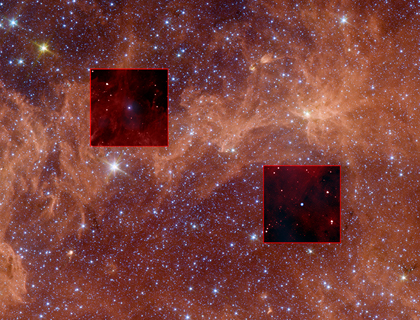Hunting for the Milky Way's Heaviest Stars
Like looking for Easter eggs in a lawn of long grass, the hunt for the Milky Way's most massive stars takes persistence and sharp eyes. In their stellar search through our Galactic backyard, astronomers have used powerful telescopes sensitive to X-ray and infrared radiation to find evidence for a substantial population of X-ray emitting massive stars.
This image shows infrared data from NASA's Spitzer Space Telescope near the plane of the Milky Way galaxy. Both outlined boxes contain an artificially darkened view of the Spitzer data, to highlight a bright X-ray source (blue) detected at the center of each square with NASA's Chandra X-ray Observatory. Each X-ray source coincides with a strong infrared signal.
Analysis of the X-ray and infrared data, as well as optical and radio observations, reveals that these bright sources are, in fact, extremely massive stars. Two other massive stars have also been found near the plane of the Milky Way using similar methods. Deep observations from ESA's XMM-Newton also provided valuable information for these other two objects. All four of these stars are thought to be at least 25 times more massive than the Sun and lie between 7,500 and 18,000 light years from Earth. These stars are expected to last only a few million years and will end their lives with supernova explosions.
http://www.chandra.harvard.edu/photo/2011/massive/
-Megan Watzke
Category:
- Log in to post comments

